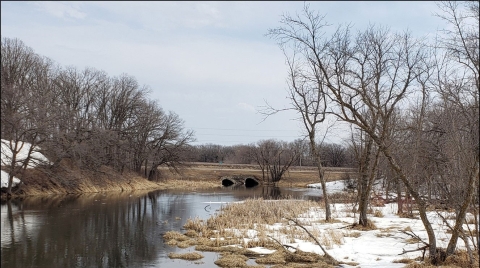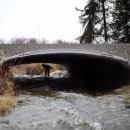States
MinnesotaThis project will reconnect a recovering native lake sturgeon population to 20 miles of critical spawning habitat, while furthering efforts to reconnect upstream Tribal restoration areas to the broader Red River Basin population recovery effort. This will be accomplished by replacing two undersized culverts with two span bridges where the U.S. Highway 10 divided expressway crosses the Otter Tail River. The present culverts create high velocities impassible to fish during the critical spring spawning period. The restored channel will restore fish passage fish passage
Fish passage is the ability of fish or other aquatic species to move freely throughout their life to find food, reproduce, and complete their natural migration cycles. Millions of barriers to fish passage across the country are fragmenting habitat and leading to species declines. The U.S. Fish and Wildlife Service's National Fish Passage Program is working to reconnect watersheds to benefit both wildlife and people.
Learn more about fish passage , improve sustainability of culturally significant fish populations for local Tribes, and contribute to regional transportation improvements.
Project Quick Facts:
| Location | Minnesota |
| NFPP Project Funding | $3,906,000 |
| Restoration Techniques | Culvert replacement, channel restoration |
| Partner Project Lead | Minnesota Department of Natural Resources |
The National Fish Passage Program combines technical expertise with a track record of success.
Implemented primarily through the Service's Fish and Wildlife Conservation Offices, the National Fish Passage Program provides financial and technical assistance to partners across the country. Since 1999, the program has worked with over 2,000 local communities, Tribes, and private landowners to remove or bypass over 3,400 barriers to fish passage and reopen access to over 61,000 miles of upstream habitat for fish and other animals. Staff have expertise in fish migration and biology as well as financial, engineering, and planning assistance to communities, Tribes, and landowners to help them remove barriers and restore rivers for the benefit both fish and people.
Fish passage project proposals can be initiated by any individual, organization, government, or agency. However, proposals must be submitted and completed in cooperation with a Fish and Wildlife Conservation Office. (Please note that fish passage projects being used for federal or state compensatory mitigation or required by existing federal or state regulatory programs are not eligible for funding through the National Fish Passage Program.)
CONTACT A FISH PASSAGE COORDINATOR IN YOUR AREA TO GET STARTED.



